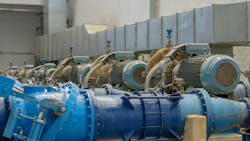Top 3 Problems With Motors
1. Bearing failures: Bearings are critical components of motors, and their failure can lead to catastrophic consequences. Bearing failures can occur due to various reasons, such as improper lubrication, contamination, misalignment or excessive vibration. They can cause increased friction, excessive heat generation and, ultimately, complete motor failure.
2. Insulation breakdown: The insulation system in motors is designed to protect the windings from electrical and thermal stresses. However, insulation can degrade over time due to factors like moisture, chemical exposure, overheating or mechanical stress. Insulation breakdown can lead to short circuits, winding failures and potential fire hazards, posing significant safety risks in the chemical industry.
3. Voltage imbalances: Motors in the chemical industry often operate on three-phase power supplies. Voltage imbalances, where the voltage levels across the three phases are not equal, can cause excessive heating, vibration and premature motor failure. Voltage imbalances can be caused by issues in the power distribution system, faulty connections or unbalanced loads on the motor.
To mitigate these problems, proper motor selection, installation and maintenance practices are essential. Regular monitoring, condition-based maintenance and predictive maintenance techniques can help identify potential issues before they lead to costly failures. Additionally, implementing appropriate safety measures, such as proper grounding, overcurrent protection and arc-flash mitigation strategies, can help ensure the safe and reliable operation of motors in the chemical industry.
Motors' versatility and reliability make them indispensable in the chemical industry. They enable the efficient and continuous operation of various processes and contribute to the production of a wide range of chemical products. Proper troubleshooting is important. Here are a few questions that were posed to our motors expert, Tom Bishop, over the years.
Bishop is a senior technical support specialist with the Electrical Apparatus Service Association (EASA). He joined the EASA staff in 2002 with over 30 years of hands-on and engineering experience at electrical machinery manufacturing and apparatus service firms. He has a BS in Electrical Engineering and is a licensed professional engineer.
Bishop has authored dozens of technical articles and papers, and presented numerous seminars on electric motor application, maintenance and repair. In addition, he is chairman of EASA’s Technical Services Committee and a principal member of the National Fire Protection Association Electrical Equipment Maintenance Committee (NFPA 70B).
How can I avoid smoking the motor at startup?
I have a 12.25-inch disk when loaded with components equals about eight pounds. Others in the same field have a problem smoking the motor during startup. I want to run at a variable speed to 3600 rpm.
It is important to keep the motor as small as possible. The best advice is to consult a motor and drive manufacturer. Beyond startup, many issues will need to be addressed, such as how often the motor starts, physical space limitations and the type of motor — conventional AC and VFD or brushless DC, etc.
How can we increase the speed of an electric motor?
How can we increase the speed of an electric motor by supplying energy to a pump through a variable frequency drive (VFD) system? Is the motor power sufficient to prevent overloading?
The VFD will indicate the frequency range's capabilities, often up to 50% above the supply line frequency.
If the motor is rated for use with an inverter for the required speed range and its power capability will not be exceeded, the VFD and motor should be suitable.
How do you correctly test the motor after repairing or overhauling?
How do you correctly test the motor after repairing or overhauling? Is there any fixed procedure for taking measurement values?
When testing without load, everything is OK. But when I put the load/taking online with rotating equipment (for example, pump), it becomes trip overload. Why did this happen?
There are reliable acceptance tests that should be part of a company's repair specification. The simplest is to document the no-load amperage (NLA) of the electric motor operating at rated voltage. A rule of thumb is that most motors should draw approximately 1/3 of the rated full load current (FLA). There are exceptions -- motors that have very low running speeds, and 2-pole motors (3600 rpm on 60 Hz systems, or 3000 rpm on 50 Hz). Since most electric motors are 4-poles (1800 rpm at 60 Hz, or 1500 rpm at 50 Hz), this quick check offers a reasonable confirmation that nothing is drastically wrong.
More stringent tests cost more but are justifiable for critical applications and locations where installation is difficult. Some service centers have a dynamometer and can simulate the actual load conditions.
Formula For Selecting A Motor
I want to select a motor for a 120T/hr screw conveyor. Please help with the formula and other requirements.
In simple terms, the formula for horsepower is 1hp = 33,000 pound-feet per minute. For a conveyor, you will need to determine the distance to be moved in a period of time and the effects of friction. The effect of friction is that the hp required will increase by 1/(1- CF). For example, if the coefficient of friction is 0.2, the hp required will need to be increased by 1/(1 - 0.2) or 1.25. Another factor that is not simple to deal with is the starting torque required if the conveyor is loaded. For that, you should consult with the motor manufacturer.
About the Author
Traci Purdum
Editor-in-Chief
Traci Purdum, an award-winning business journalist with extensive experience covering manufacturing and management issues, is a graduate of the Kent State University School of Journalism and Mass Communication, Kent, Ohio, and an alumnus of the Wharton Seminar for Business Journalists, Wharton School of Business, University of Pennsylvania, Philadelphia.

